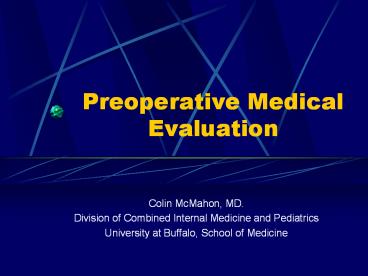Preoperative Medical Evaluation - PowerPoint PPT Presentation
1 / 25
Title:
Preoperative Medical Evaluation
Description:
Preoperative Medical Evaluation Colin McMahon, MD. Division of Combined Internal Medicine and Pediatrics University at Buffalo, School of Medicine – PowerPoint PPT presentation
Number of Views:234
Avg rating:3.0/5.0
Title: Preoperative Medical Evaluation
1
Preoperative Medical Evaluation
- Colin McMahon, MD.
- Division of Combined Internal Medicine and
Pediatrics - University at Buffalo, School of Medicine
2
What are You Really Being Asked to Do?
- Assess risks of anesthesia
- Assess the risks of the procedure
- Manage complicated medical problems
- Predict the future
3
General Considerations
- Limit number of recommendations
- Focus on critical problems
- Be specific about drugs, dosage and intervals
- Dont ask the surgeon to think
4
General Approach
- Diagnosis
- Develop a problem list
- Treatment
- Directed toward decreasing surgical risk
- Prognosis
- Anesthesia complications
- Procedural complications
5
Misconceptions
- Advise on type of anesthesia
- General, local or spinal
- Change ongoing treatment plans
- Initiate diagnostic work-ups
6
Risk Evaluation
- Overall perioperative mortality 0.3
- Anesthesia induction 10
- Intraoperatively 35
- Postoperatively (48 hours) 55
7
ASA Classification
8
Procedure Risk
- Low risk
- Eye surgery, oral surgery, DC, hysterectomy,
herniorrhaphy - High risk
- Craniotomy and cardiovascular
9
Specific Risks
- Pulmonary
- Cardiac
- Hematologic
- Endocrine
- Thromboembolism Prophylaxis
10
Pulmonary Risks
- Complications
- Hypoventilation
- Pneumonia
- Atelectasis
- Occur in about a third of patients
- Accounts for half of perioperative mortality
11
Whos at Risk
- Smokers
- COPD
- Obesity
- Age gt 70
- Thoracic surgery
- Upper abdominal surgery
- Anesthesia gt 2 hours
12
Risk Assessment
- FEV1 gt 2L, probably safe
- FEV1 between 1 and 2L, increased risk
- FEV1 lt1L, high risk
13
Risk Management
- Quit smoking
- Bronchodilator therapy
- CPT
- Early treatment of bronchitis
- Early mobilization
14
Cardiac Risks
- Complications
- Myocardial Infarction
- CHF
- Hypertension
- 50 fatal, 60 silent
- Increased mortality post-op day 3
15
Whos at Risk
- Recent MI
- Valvular heart disease
- CHF
- Unstable angina
- Diabetes
16
Risk Assessment
- Goldman Cardiac Risk-Index for Noncardiac Surgery
- American College of Cardiology Risk Assessment
17
Risk Management
- Monitor for perioperative ischemia
- Repair severe aortic stenosis first
- Treat CHF aggresively preoperative
- Postpone non-emergent procedures for at least 6
months after an MI
18
Hemetologic Risks
- Complications
- Thromboembolic
- Bleeding
19
Whos at Risk
- Polycythemia vera
- Thrombocytopenia
20
Risk Assessment
- Hematocrit
- Platelet count
- Bleeding time
- PT/PTT
21
Risk Management
- Phlebotomy to decrease hct lt 45
- Maintain plts gt 50,000
22
Endocrine Risks
- Thyroid storm
- Diabetic complications
23
Risk Management
- Good control of thyroid function for at least 3
months prior - Hold oral hypoglycemics
- Reduce insulin by half
24
Thrombembolic Prophylaxis
- Specific to surgery
- Increased risk
- Elderly
- Obesity
- Prolonged anesthesia
- Immobility
25
Other Considerations
- Antibiotic prophylaxis
- Herbal medicines
- Geriatric patient































